
On the night of the Thirty First of January, sixteen years ago, I experienced some of the wildest weather i’ve ever been out in. I remember the night well because I had to walk over two miles home from work in it, and also because of how strange a night it was.
At the time I worked in a pub in Poulton-le-fylde and rented an apartment down the road in Thornton-cleveleys, on this particular night, a Thursday, I had just left after a long night’s shift (I had two jobs at the time) and set off down the road for home. I didn’t always used to walk back but on this night I must have forgotten to bring my wallet or any cash for a bus or taxi.
The weather that night was truly horrible, turning the corner at the Castle Gardens pub the wind almost blew me off my feet! As I reached the stretch of Fleetwood Road between Carleton and the Amounderness way bypass I could glimpse, off in the distance on my left, through brief pauses in the driving rain, what looked like an odd, large and brightly-lit white building, where there shouldn’t be one.
As I made my way down the road in the storm I kept glancing at this ‘building’, wondering what it could be, was it Norbreck Castle hotel? nope, that’s further up the front and looks completely different, I just couldn’t place it at all. Once over the roundabout I noticed that there seemed to be a helicopter with a searchlight hovering above this peculiar looking building, pondering this strange sight and rather bedraggled I got back home and didn’t really think too much about it until the next day.
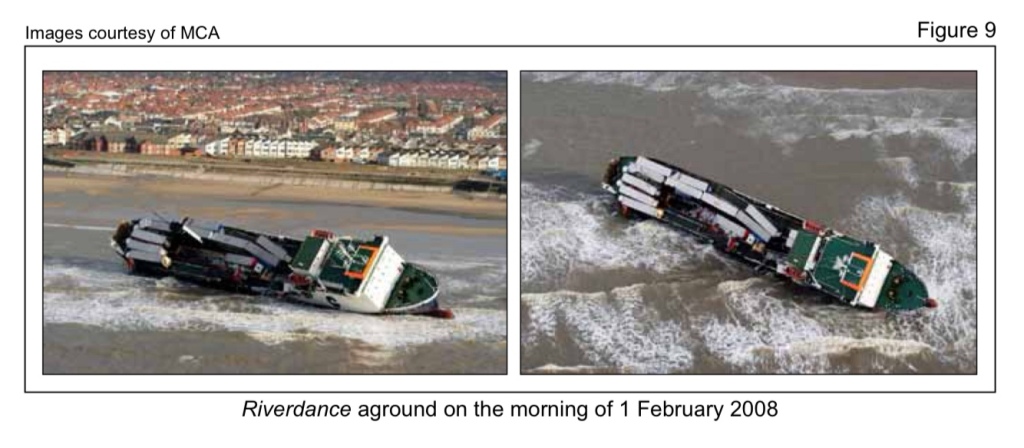
Riverdance
The odd, brightly-illuminated, out-of-place building I had seen glaring in the distance through the horizontal rain and spray had been the superstructure of the Riverdance, which had run aground in the storm.
Riverdance was a ‘Ro-pax’ ferry (roll-on/roll-off passenger) in service with Seatruck Ferries and plying the Warrenpoint/Heysham route. She was built at Bremerhaven in Germany in 1977 as ‘Mashala’ and renamed several times in her life; ‘Halla’ in 1987, ‘Tikal’ in 1988 and ‘Schiaffano’ in 1989. Her first tour of service was on the Mediterranean and in 1993 she moved to the Irish sea where she sailed under the name of ‘Sally Eurobridge’.
At over 6000 tonnes and 116 metres in length she was a sizeable ship theoretically capable of riding out the biggest waves the Irish sea could throw at her, but at 7:20 pm on Thursday the 31st of January 2008 she came into serious trouble.

(MAIB)
Stormy Seas
The Master of the vessel, Captain Jim Wright, had, as is standard procedure before deciding to set sail or not, checked the latest Met Office weather report “South West veering North West, gale 8 to storm 10 veering North West 6 to gale 8, rough or very rough, rain then showers, visibility moderate or poor”, it said, with the outlook for the following 24 hours being “Storms expected in Irish Sea”.
Being no stranger to rough seas and already several hours late Jim decided to go ahead with the 9 hour voyage from Warrenpoint. He was an experienced sailor after all, having been a seaman since 1977 and a captain since 1991 and Riverdance was “renowned for her good seakeeping”, so he felt confident that everything would go smoothly.
The journey did go well and without incident up until about 6:30 pm, at a part of the Irish sea called the Lune Deep, roughly 7 miles offshore. At this point the vessel, which had been coping with the seas very well until now, encountered a series of powerful 20ft waves, described in the exaggerated manner newspaper editors are fond of as ‘freak waves!’.
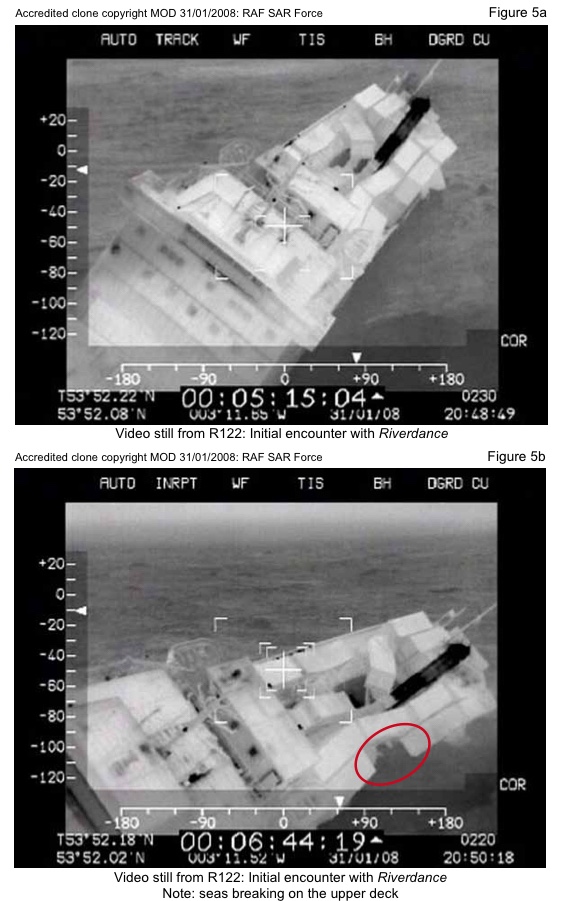
(MAIB)
Freak Waves!
The ‘freak waves’ were a result of the storm-driven swells and currents meeting the sea-floor topography of the Lune deep and they met the ferry side-on, causing her to repeatedly roll to her left (port in nautical parlance). This in turn led to some of the 54 trailers on board, mainly semi-trailers, and their cargo shifting.
It was discovered later in the investigation into the incident, as can be seen in this Riverdance Safety Flyer (the full report is linked at the end of this article) issued by the MAIB (Marine Accident Investigation Branch) that the ‘weights and disposition’ of the cargo had not been assessed before departure. Nor had the ship’s ballast been adjusted to compensate for it, which contributed hugely to the listing of the ferry and its subsequent loss.
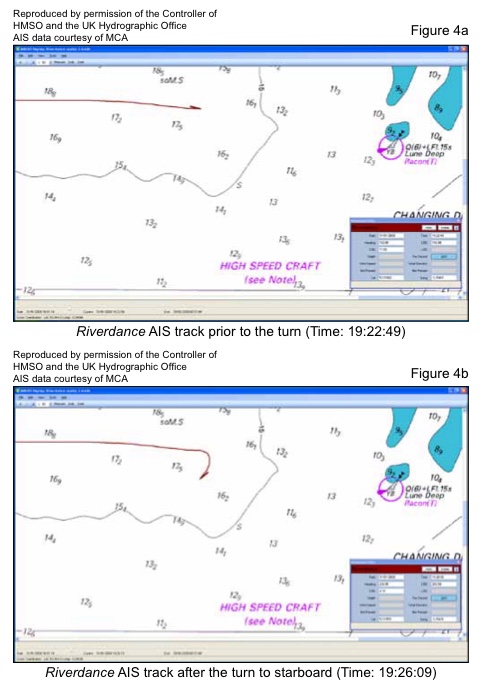
Only 2° from capsize
The listing was so violent that at one point the vessel was tilted on its side by an estimated 50°, only 2 degrees or so away from capsize. In an interview some years later Jim recounted; “That’s when the ship rolled even more to port and the cargo in all the trailers broke free. That’s when she went down to 45 degrees plus.”
With the ship listing badly and lorry-trailers sliding across the deck, Jim responded by turning off the auto-pilot and steering to his right (starboard) to bring Riverdance’s bow to face the storm with its 80+ mph gusts, both standard procedures, but this only exacerbated matters.

Mayday declared
Riverdance, with her 4 passengers and 19 crew quickly found herself in dire peril, Jim declared Mayday and a major rescue mission was launched, involving 3 helicopters from the Irish Coast Guard, Royal Navy and Royal Air Force and 2 lifeboats from Lytham and Fleetwood, afterwards the rescuers described the conditions as the “worst we have ever seen”.
Some of the passengers and crew were airlifted from the ferry, 8 were lifted from the ship when it was struggling at sea, and 6 when it was aground, this is what the helicopter I saw that night was doing.
As they were winched off the stricken vessel Jim sang humorous ditties and told jokes to keep everyone’s spirits up, the 59 yr old was the last man taken to safety. He had manned the ship to the last minute.

Ran aground
Later the investigation found that although Jim had been negligent and made serious errors in preparing Riverdance for the voyage he had potentially saved everyone on board by deciding to keep her running on diesel engines and not switching to electric motors, this proved pivotal in preventing further disaster, especially after the port engine cut out.
This and the decision to muster the crew together on the bridge to man emergency systems and run the anti-heeling pumps, which pumped ballast water around the hull to compensate for heeling, (heeling is when exterior forces such as wind and waves push a ship over to one side) before evacuating the engine room, reduced the list by 20°.
Reducing the angle of the list allowed the rescuers to winch everyone off from the port side which was the safest side for them to do so, (they had gathered on the starboard in case the vessel capsized but this made it very hard for the helicopter crews), otherwise rescue efforts, already very risky, would have been a lot more dangerous for everyone concerned.
A skeleton crew of nine volunteers stayed behind on the vessel that night, braving out the storm until about 5am, by which time the Riverdance had settled upright on the sandy bottom of the beach just opposite Anchorsholme Lane. During this time they prepared her to re-float on the next rising tide, re-secured most of the trailers and their cargo, generally tidied up and, believe-it-or-not, even swept up broken crockery in order to make her ship-shape again.
Throughout the whole ordeal nobody was seriously hurt, with only two having to be taken to hospital for symptoms of mild hypothermia.

A Sorry Sight
Sadly there was no way to right Riverdance, she had sunken too deep into the soft mud and sand, over the next few weeks an estimated 100,000 spectators (including myself) travelled to the promenade to see the sorry sight of her beached and pick through her cargo washed upon the shore for souvenirs.
Shops and businesses in Cleveleys had their busiest ever days trading and the police had to close Princess way, the shore-hugging coastal road, to traffic. Security guards prevented anyone getting too close to the wreck but, of course, anywhere you go in the UK there’s always a bunch of kids who will view something like this as a challenge and, sure enough, one night a group of them got on-board somehow, although they eventually climbed back down and were apprehended by the police.
I’m not too sure of the details of this but I do know that two urban explorers known as ‘Scott’ and ‘Stepping Lightly’, infamous for illegally scaling Blackpool tower at night also gained access to the ship under the cover of darkness, you can find a video of their misadventures on the internet somewhere.
As well as concerns about valuable equipment being pillaged the ship’s bosun, ABs, cook, stewards etc, who were on board for months at a time, if not semi- permanently, had left their personal belongings on the ship, so any trespassing was treated very seriously, I don’t know whether their cabins were above water though unfortunately the captain’s wasn’t.

Flotsam and Fuel
Beachcombers foraging the shore for flotsam found little of value, the trailers which lost their cargo were carrying timber, plastic cups and a consignment of Mcvitie’s Chocolate Digestives.
Naturally the chocolate biscuits were a bit soggy, I know this as I rooted through a tideline of them trying to find a souvenir myself. I did take an empty packet home which sat on my shelf for a few months until a girlfriend of the time threw it away when overzealously tidying up, obviously not comprehending the enormous historical value of the artefact!
Luckily nothing too toxic or dangerous was washed overboard, the 300 tonnes of fuel the ferry was carrying (there should only have been 150) remained safely in its tanks and the salvage team were later able to remove it by drilling a hole in the hull to pump it out through.
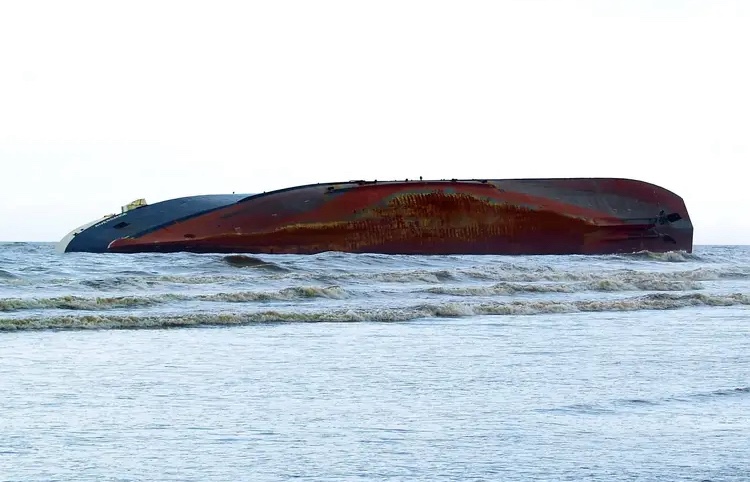
Final Resting Place
At 6000+ tonnes the weight of Riverdance not only prevented her from re-floating but was enough to cause her to sink deep into the soft sand, and by coincidence the spot where she beached happened to be right above a large United Utilities sewage outfall pipe.
This must have caused them a massive headache as utility companies don’t usually have to factor in eventualities such as 6000 tonne ships landing on their infrastructure! So after the salvage teams that arrived to pick apart the wreck left, yet another team of workmen with heavy equipment had to come and replace the long stretch of crushed pipeline so that the Fylde coast had a functioning sewer system.

Salvaging the ship
Riverdance sat, forlorn and rather dejected looking, on the sea-front for months after the storm subsided and eventually heavy machines arrived to slowly take her apart piece by piece. First the salvage crew had to make safe the remaining trailers, some of them dangling over the gunwale precariously, then move onto the rest which were piled together in a dangerous tumble on the deck. In this video you can see that during the storm some of the trailers broke loose but I don’t know how many or what happened to them.
Deemed a ‘constructive loss’ after being battered by the surf and contorted by lying on her side on the sand the initial plan was to winch her out to sea and tow her to Liverpool to be scrapped, but she had become too weakened for this to be possible. So the salvage team, based in Lancaster, had to go back to the drawing board, literally too, as they were relying upon paper plans of her sister ship, ‘Moondance’, drawn up in the 70’s, to get an idea of her structure.
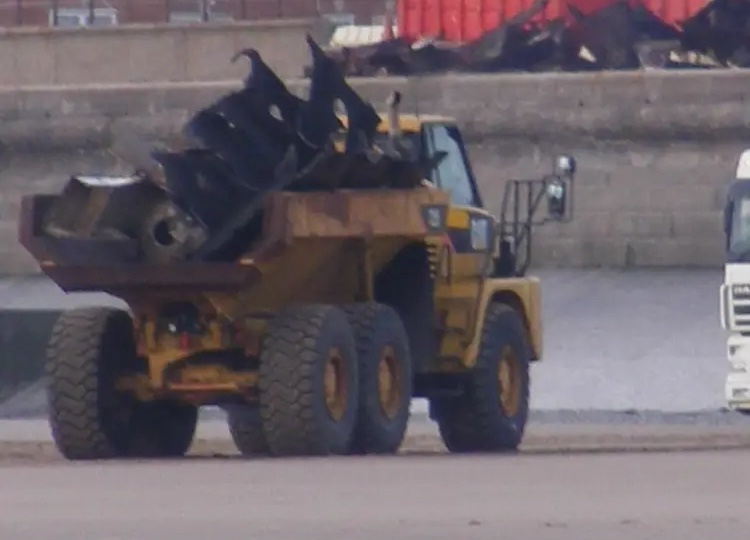
Breaking down the ship took until October, with the first month spent gutting the interior, this was carried out by a workforce of 50 men who stayed in portacabins on the Promenade, working whenever the tide was out, whether it be day or night. I can remember watching the flashes of their cutting torches illuminating the beach at night with my friend and how eerie a sight it was.
Just before dawn on May the 12th a work-shift of 12 had to evacuate the wreck after two tractor units in the hold caught fire when sparks from the cutting torches fell onto them. Everything about the job was extremely hazardous for the salvage crew, however the blaze was extinguished by the rising tide so the fire crew didn’t have to venture aboard.
The workers continued, dissecting the hull and removing it in sections by crane, and by midsummer the second of Riverdance’s two 40 tonne engines was removed from deep within the hold. By October, after environmental inspectors had found that the salvage firm, Smit salvage, had carried out an excellent and thorough job of preventing any pollution contaminating the coast, there was no trace of the Riverdance left at all.
As is tradition the contractors kept the steel plate bearing the ship’s name.

This is the Marine Accident Investigation Branch report into the incident and if you you want to visit Cleveleys yourself to see the site of the wreck I recommend checking out visit fylde coasts website for more details, it’s quite a pleasant little seaside town, at least that’s when it’s not blowing a Force 10 gale!
A B-H
Great post ✍️
LikeLiked by 1 person
Thanks 🙂
LikeLike
I’d forgotten this. That’s a brilliantly written account. What a wild night and a miracle everyone got off okay.
LikeLiked by 2 people
Thanks, i do remember it very well, especially hearing everybody talking about it the day afterwards at work, it is quite amazing how nobody was hurt!
LikeLiked by 1 person
This is a superb account, Alexander. I particulary like the way you open it with a personal anecdote. Well done.
LikeLiked by 1 person
Thanks, it was a very strange night which i remember very clearly, i’ll have to pop down to cleveleys this summer, i’ve always been quite fond of the place and i’d like to see the shipwreck memorial
LikeLike
The shipwreck memorial is a must see, along with other art on the new Cleveleys sea defences.
LikeLiked by 1 person
I’ll definitely have to pop down, maybe a detour to Skipool too, that place is very cool!
LikeLiked by 1 person
Ancient relics at Skipool.
Traffic is horrendous around there at the moment with semi opening of the new road.
LikeLiked by 1 person
Brilliant, fascinating!
LikeLiked by 1 person
Thanks, glad you liked it, took a while to write this one!
LikeLike